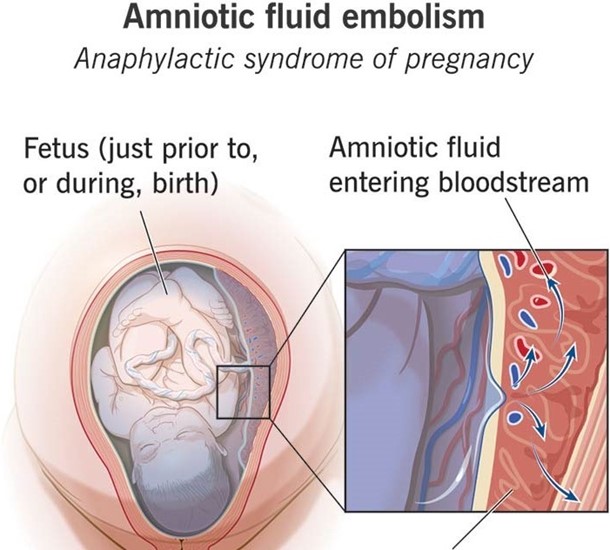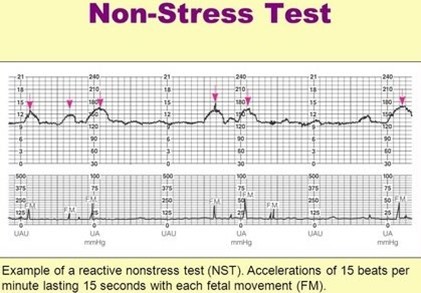Following a normal spontaneous vaginal delivery (NSVD), a 28 year old G3 now P3 mother develops sudden onset shortness of breath, hypoxia and cyanosis. The delivery room nurse quickly recognizes these symptoms as possible:
Select one:
Manifestations of uteroplacental insufficiency.
Manifestations of prolapsed cord.
Manifestations of anaphylactoid syndrome of pregnancy.
Manifestations of an acute asthmatic episode.
The Correct Answer is C
Choice A Reason: Manifestations of uteroplacental insufficiency. This is an incorrect answer that describes a different condition that affects the fetus, not the mother. Uteroplacental insufficiency is a condition where the placenta fails to deliver adequate oxygen and nutrients to the fetus, which can result in fetal growth restriction, distress, or demise. Uteroplacental insufficiency does not cause shortness of breath, hypoxia, or cyanosis in the mother.
Choice B Reason: Manifestations of prolapsed cord. This is an incorrect answer that refers to another condition that affects the fetus, not the mother. Prolapsed cord is a condition where the umbilical cord slips through the cervix before the baby and becomes compressed by the fetal head, which can reduce oxygen flow to the fetus. Prolapsed cord does not cause shortness of breath, hypoxia, or cyanosis in the mother.
Choice C Reason: Manifestations of anaphylactoid syndrome of pregnancy. This is because anaphylactoid syndrome of pregnancy, also known as amniotic fluid embolism, is a rare and fatal condition where amniotic fluid enters into the maternal bloodstream and causes an allergic reaction, which can lead to respiratory failure, cardiac arrest, coagulopathy, and coma. Anaphylactoid syndrome of pregnancy can occur during or after labor and delivery, especially in cases of NSVD, multiparity, advanced maternal age, or placental abruption.
Choice D Reason: Manifestations of an acute asthmatic episode. This is an incorrect answer that assumes that the mother has a history of asthma or an allergic trigger. Asthma is a chronic inflammatory disorder of the airways that causes wheezing, coughing, chest tightness, and dyspnea. Asthma can be exacerbated by pregnancy or labor, but it is not a common cause of sudden onset respiratory distress in the postpartum period.

Nursing Test Bank
Naxlex Comprehensive Predictor Exams
Related Questions
Correct Answer is B
Explanation
Choice A Reason: A fetal heart rate baseline of 140 with one acceleration to 155 for 15 seconds within 30 minutes. This is an incorrect answer that indicates a non-reactive NST, which is a test that does not meet the criteria for a reactive NST. A non-reactive NST may suggest fetal hypoxia, distress, or sleep, but it does not necessarily indicate a problem. A non-reactive NST may require further testing or stimulation to elicit a reactive result.
Choice B Reason A fetal heart rate baseline of 140 with two accelerations to 160 for 15 seconds within 20 minutes. This is because this strip meets the criteria for a reactive NST, which is a non-invasive test that evaluates fetal well- being and oxygenation by measuring the fetal heart rate response to fetal movements. A reactive NST is defined as having at least two accelerations of the fetal heart rate that are at least 15 beats per minute above the baseline and last for at least 15 seconds within a 20-minute period.
Choice C Reason: A fetal heart rate baseline of 130 with two accelerations to 135 for 15 seconds within 20 minutes. This is an incorrect answer that indicates a non-reactive NST, which is a test that does not meet the criteria for a reactive NST. The accelerations in this strip are not sufficient in amplitude, as they are only 5 beats per minute above the baseline, instead of at least 15 beats per minute.
Choice D Reason: A fetal heart rate baseline of 150 with two accelerations to 160 for 10 seconds within 20 minutes. This is an incorrect answer that indicates a non-reactive NST, which is a test that does not meet the criteria for a reactive NST. The accelerations in this strip are not sufficient in duration, as they last only for 10 seconds, instead of at least 15 seconds.

Correct Answer is A
Explanation
Choice A Reason: Insulin needs decrease in the first trimester, but increase in the second trimester as the woman's body becomes more insulin-resistant. This is because this statement describes the typical patern of insulin requirements during pregnancy for women with pre-existing diabetes. Insulin needs decrease in the first trimester due to increased insulin production by the pancreas, increased insulin sensitivity by the tissues, and increased risk of hypoglycemia due to nausea and vomiting. Insulin needs increase in the second trimester due to increased levels of placental hormones such as human placental lactogen (hPL), which antagonize insulin action and cause insulin resistance.
Choice B Reason: Vascular disease that always accompanies diabetes slows fetal growth. This is an incorrect answer that makes a false and exaggerated claim about diabetes and fetal growth. Vascular disease does not always accompany diabetes, but it can be a complication of long-term or poorly controlled diabetes that affects blood vessels and circulation. Vascular disease can affect fetal growth by reducing placental perfusion and oxygen delivery, but it is not the only factor that influences fetal growth. Other factors include maternal nutrition, genetics, infections, or anomalies.
Choice C Reason: The risk of ketoacidosis decreases during the length of the pregnancy. This is an incorrect answer that contradicts the evidence and guidelines on diabetes and ketoacidosis during pregnancy. Ketoacidosis is a metabolic emergency where high levels of ketones accumulate in the blood due to insufficient insulin or excessive glucose utilization, which causes acidosis, dehydration, electrolyte imbalance, and coma. Ketoacidosis can occur in women with diabetes during pregnancy due to infection, stress, starvation, or inadequate insulin therapy. The risk of ketoacidosis does not decrease during the length of the pregnancy, but rather increases in the second and third trimesters due to increased insulin resistance and glucose production.
Choice D Reason: The baby is likely to have a congenital abnormality because of the uncontrolled diabetes. This is an incorrect answer that implies a negative and deterministic outcome for the baby. Congenital abnormalities are structural or functional defects that are present at birth, which can affect various organs or systems in the baby.
Congenital abnormalities can be caused by genetic or environmental factors, or a combination of both. Diabetes can increase the risk of congenital abnormalities, especially if the blood glucose levels are high during the first trimester, when organogenesis occurs. However, the risk of congenital abnormalities is not inevitable or predictable, and it can be reduced by maintaining good glycemic control before and during pregnancy.
Whether you are a student looking to ace your exams or a practicing nurse seeking to enhance your expertise , our nursing education contents will empower you with the confidence and competence to make a difference in the lives of patients and become a respected leader in the healthcare field.
Visit Naxlex, invest in your future and unlock endless possibilities with our unparalleled nursing education contents today
Report Wrong Answer on the Current Question
Do you disagree with the answer? If yes, what is your expected answer? Explain.
Kindly be descriptive with the issue you are facing.
